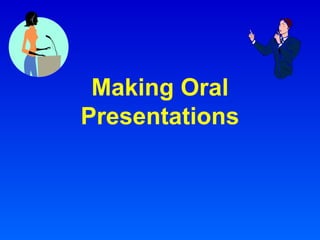
Making an oral presentation 5
- 2. 2 - You must be the Centre of Attention • Remember, you are delivering your message in person, and in front of other people. • This means that your message will not simply be what you are saying, but how you are saying it.
- 3. Factors to consider Let us examine each of the following in turn because they all have an important bearing on the presentation. • Your voice. • Your use of eye contact. • Your positioning. • The use of body language. • Involving hand/ face/ whole body gestures. • Your overall appearance.
- 4. Dress • Your appearance is part of your (non-verbal) message. • Dress appropriately.
- 5. Oral Presentations We can consider a Presentation in 2 parts 1. Preparing the Presentation. 2. Delivering the Presentation.
- 7. Hand-Outs Try not to provide the audience with handout materials before you begin. To do so encourages your audience to read rather than listen. If you must provide written material, be sure the material is coordinated with your presentation. That way, you have a better chance of keeping your audience's attention on what you are saying.
- 8. Visual Aids • Visual aids significantly improve the interest of a presentation. However, they must be relevant to what you want to say. A careless design, or a poor slide can simply get in the way of the presentation. • What you use depends on the type of talk you are giving.
- 9. Using Slides • Make sure you know in advance how to operate the equipment and also when you want particular displays to appear. Sometimes a technician will operate the equipment. • Arrange beforehand, what is to happen and when and what signals you will use. Edit your slides as carefully as your talk - if a slide is superfluous then leave it out. If you need to use a slide twice, duplicate it. • And always check your slides - for typographical errors, consistency of fonts and layout.
- 10. Use of Slides Try to limit words per slide. Use a reasonable size font and a typeface which will enlarge well. Typically use a minimum of18pt Times Roman on OHPs, and preferably larger. A guideline is: if you can read the OHP from a distance of 2 metres (without projection) then it's probably OK. Avoid using a diagram prepared for a technical report in your talk. It will be too detailed and difficult to read. Use colour on your slides, but avoid orange and yellow which do not show up very well when projected. For text only, white or yellow on blue is pleasant to look at and easy to read.
- 11. Oral Presentations We can consider a Presentation in 2 parts 1. Preparing the Presentation. 2. Delivering the Presentation. We have said much about part 2. Let us look at the preparation part
- 12. Other Aspects
- 13. Hand-Outs Try not to provide the audience with handout materials before you begin. To do so encourages your audience to read rather than listen. If you must provide written material, be sure the material is coordinated with your presentation. That way, you have a better chance of keeping your audience's attention on what you are saying.
- 14. Finally Enjoy yourself. The audience will be on your side and want to hear what you have to say! Say it with a Smile